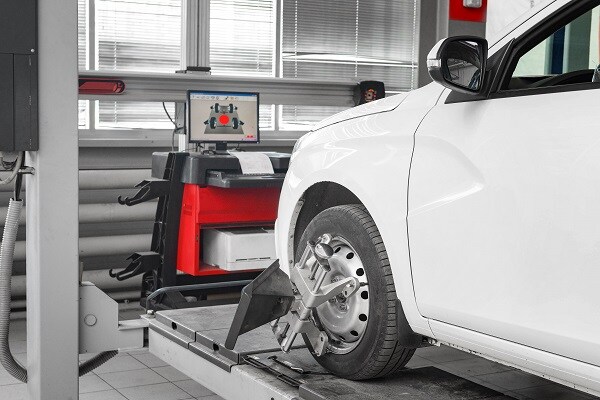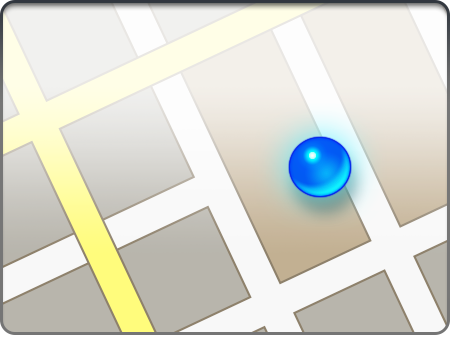We all want a smooth drive when we hit the road. One of the key factors contributing to the smoothness of the drive is the wheel alignment. You should regularly perform this simple maintenance task on your vehicle to ensure a smooth ride, improve gas mileage, and help preserve the life of your tires. A wheel alignment involves adjusting the components of your car's suspension to ensure the wheels' angles are ideal for driving. At Boardman Mitsubishi, you can schedule your wheel alignment today with our simple online tool. Give our friendly team a call at (888) 833-6450 today!
What Happens During a Wheel Alignment?

A wheel alignment involves much more than just moving your car's tires. It also includes adjusting the suspension of your car to make sure your tires are at the optimal angles to improve your overall driving experience. Specifically, we examine and adjust three different angles: camber, toe, and caster.
Camber
Camber is the inward or outward angle of your tires when looking at your vehicle from the front. If the top of the tire is tilted inward toward your vehicle, this is called negative camber. If the top of the tire is tilted outward away from your vehicle, this is positive camber. On most cars, a typical camber is a negative camber of zero to 2 degrees. If your tires' camber is incorrect, you may experience handling issues, as well as excessive wear on your tires.
Toe
The toe is the angle of your car's wheels when viewing them from above. To imagine this angle, look down at your feet and toes. If you angle your toes in, this is considered toe-in alignment on your wheels. If you angle your toes out, this is regarded as toe-out alignment. Most manufacturers recommend a slight toe-in alignment for optimal performance. If the toe angle of your wheels is not correct, you may experience excessive wear on your tires.
Caster
If you view your car from the side, the caster is the angle of the steering axis. A positive caster means the steering axis is pointed toward the diver, while a negative caster means it's pointed toward the front of your vehicle. The caster is the one angle of a wheel alignment that doesn't really affect tire wear. Rather, an incorrect caster angle could create issues with the steering and overall handling of your vehicle.
Why Do I Need a Wheel Alignment?
Cars are full of moving parts, and over time, these parts can shift away from their original positions. The alignment of your wheels slowly changes over time due to the settling of your car's suspension. In addition, interacting with things on the road, such as potholes, speed bumps, curbs, and road debris, can cause your wheels to go out of alignment.
How Often Should I Have My Wheels Aligned?
Because all cars will experience alignment issues over time, it's best to book a wheel alignment at least every other oil change or whenever you have your tires replaced. At the bare minimum, this would be approximately every two to three years. However, there are times when you should get your alignment checked more frequently. These times include:
- After a vehicle accident.
- After a noticeable impact with a pothole, a curb, or road debris.
- Anytime you have your vehicle lifted and lowered for other maintenance events.
- When a mechanic works on or replaces components of your steering or suspension.
- After repeated off-roading experiences.
How Can I Tell Whether My Wheels Are Out of Alignment?
The consequences of incorrect wheel alignment will manifest in two noticeable places: on the tread of your tires and in the handling of your car. If you notice issues in either of these two areas, it's most likely time to get your wheels aligned.
Take a look at the tread on your tires. If you notice that the tread pattern is worn unevenly, meaning the tread has been worn down more on either the inside or outside of the tire, this could indicate that your wheels are out of alignment. You may also notice "feathering" on your tires, which is where the tread is smooth on one side and sharper on the other. Be sure to inspect all four of your tires because improper alignment might not always affect every tire equally.
You might also notice signs of a misalignment in the handling of your car. Signs of improper alignment that are noticeable when driving include the following:
- The steering wheel is shaking, even when the road is smooth and driving conditions are ideal.
- The steering wheel is not centered - when driving straight, you notice that the top of your steering wheel is turned to the left or right.
- The car is pulling to the left or right - if your hands are off the steering wheel, your car steers to the left or right instead of in a straight line.
If you notice any of these issues with the treadwear of your tires or the handling of your car, it's best to schedule a time to bring your car in to have your wheel alignment checked as soon as possible.
Wheel alignment is an important component of your car's overall maintenance. Without proper alignment, you'll find that you need to replace your tires more frequently. This is a costly side effect that many of us want to avoid when possible. Since improper wheel alignment can also result in decreased gas mileage, you'll also notice an improvement in your gas budget when you bring your vehicle in for a wheel alignment. In addition to saving money in the long run, getting your wheels aligned will also give you improved steering and handling, as well as an overall smoother ride.
At Boardman Mitsubishi, our tire technicians are ready to help you with all your tire needs. Our tire department is well equipped to provide you with fast and friendly service that will ensure your car's tires hit the road in the best shape possible. Call our service department at (888) 833-6450 today and we'll take care of you!
